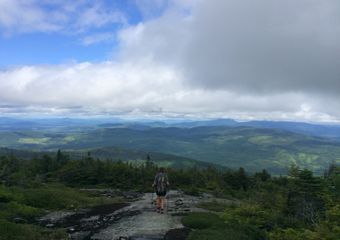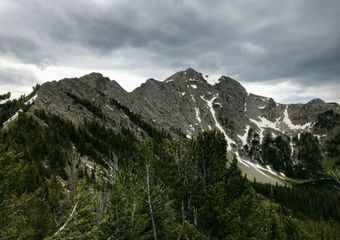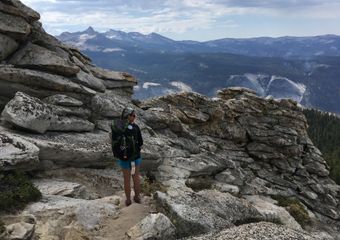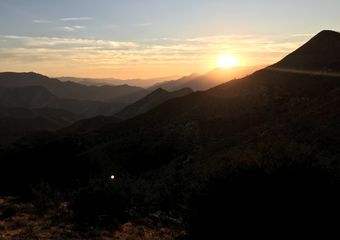ATC Requests Appalachian Trail Closed Until 4/30
The Appalachian Trail Conservancy and 29 of the 31 AT maintaining clubs in early April asked the federal government to close the entire Appalachian Trail until April 30 because of COVID-19.
The ATC delivered a letter on April 1 to the secretaries of the US Departments of Interior and Agriculture, the deputy director of the National Park Service, and the chief of the US Forest Service recommending that the trail be closed immediately, lasting until April 30. Trail managers would meet intermittently to determine whether it is safe to reopen the trail, the ATC said.
The letter cited “a growing risk of visitors spreading COVID-19 among other hikers, nearby communities and beyond.”
The federal departments did not act on the ATC’s request, but much of the trail from Georgia to Maine has been closed at trailheads and through state parks.
In Virginia, Shenandoah National Park announced on its website on April 8 that it was closing until further notice based on the recommendation of the Rappahannock Rapidan Health District of the Virginia Department of Health. The park posted on April 27 that it was still closed for all uses.
The park had already stopped all overnight backcountry camping effective on March 26.
Earlier the week of April 5 in Virginia, 27 miles of the AT known as the Triple Crown of Virginia were closed on National Park Service land between VA Route 624 (Newport Road) and VA Route 652 (Mountain Pass Road), which includes McAfee Knob and Tinker Cliffs. Access to Dragon’s Tooth, which is on US Forest Service-owned land, has already been closed.
New Jersey has reopened state parks and forests. The AT crosses Abram S. Hewitt State Forest, Wawayanda State Park, High Point State Park, Stokes State Forest, and Worthington State Forest.
The National Park Service already has closed all overnight shelters and privies on land administered by the Appalachian National Scenic Trail Park Office, effective immediately.
The shelters and privies are in Virginia (11 shelters, 12 privies), Maryland (one shelter, two privies), Pennsylvania (eight shelters, six privies), New Jersey (one shelter, one privy), New York (five shelters, five privies), Connecticut (seven shelters, 16 privies), Massachusetts (one shelter, four privies), and Maine (22 shelters, 29 privies).
The Park Service said in a statement here that closing shelters “will prevent trail users from congregating in close proximity to one another and encourage proper social distancing recommendations. Overnight trail users are encouraged to use a tent, and tent usage is authorized in the area surrounding the shelters. Closing of privies will prevent trail users from entering confined spaces where disease spreads without proper sanitation, and will discourage visitors from using facilities that do not meet cleanliness standards. With privies closed, hikers should dig a cat hole more than 200 feet from water sources and camping areas. The use of tents instead of shelters, and cat-holes for human waste disposal, is a reasonable mitigation to help protect our visitors.”
Also, Nantahala and Pisgah National Forests in North Carolina and Cherokee National Forest in Tennessee have shut down trailhead facilities and other access points to the Appalachian National Scenic Trail to prevent groups from congregating and to protect public health and safety.
The statement here said the following sites were affected:
Wayah Bald: Nantahala National Forest
Cheoah Bald: Nantahala National Forest
Hampton and Dennis Cove Trailheads (Laurel Falls): Cherokee National Forest
Osborne Farm: Cherokee National Forest
Max Patch: Cherokee and Pisgah National Forests
Roan Mountain/Carvers Gap: Cherokee and Pisgah National Forests
Lovers Leap: Pisgah National Forest
The George Washington and Jefferson National Forests temporarily shut down trailhead facilities and other access points to the Appalachian National Scenic Trail to prevent groups from congregating and to protect public health and safety. The Forest Service said dispersed camping and other activities that support social distancing and small groups are allowed.
In addition to Appalachian Trail-dedicated parking lots, the following sites are temporarily shut down:
Jennings Creek Trailhead
Petite’s Gap Trailhead
Long Mountain Wayside Trailhead
Mount Pleasant/Hog Camp Gap Trailhead
James River Footbridge Trailhead
Priest/Three Ridges Trailhead
Crabtree Meadows Trailhead
SR42 Trailhead at O’Lystery Pavilion
Walker Gap Trailhead
Burke’s Garden Trailhead (SR623)
SR615 Trailhead at Laurel Creek (Suiter)
SR52 Trailhead in Bastian
I-77 Trailhead in Bastian
Price Ridge Road Trailhead (Crandon)
SR606 Trailhead (near Trent’s Store)
Angel’s Rest Trailhead
Town of Pearisburg Trailhead
Big Stoney Creek Road Trailhead (Pine Swamp/Peters Mountain Wilderness)
Cherokee Flats Day-Use Area Trailhead
SR613 Trailhead at Wind Rock
War Spur Trailhead at Captain
SR42 Trailhead (Huffman)
SR621 Trailhead (Craig’s Creek)
Audie Murphy Trailhead
SR620 Trailhead (Craig’s Creek)
Dragon’s Tooth Trailhead
Andy Layne Trail Trailhead
Whitetop Mountain/Forest Road 89 Trailhead
Elk Garden Trailhead, SR600 crossing
Scales/Forest Road 613 Trailhead (Pine Mountain Road)
Forest Road 603 Trailhead Parking (near Fox Creek Horse Camp)
Hurricane Campground/Comers Creek Road Trailhead
Hwy 16 Trailhead at Forest Road 650
NRA Headquarters/Hwy 16 Crossing Trailhead
Davis Valley Trailhead, Davis Valley Rd
Tillson Crossing Trailhead, SR 610 Nebo Road
On March 27, Chattahoochee-Oconee National Forests in Georgia temporarily closed trailhead facilities and other access points to the AT and nearby trails to prevent groups from congregating and to protect public health and safety.
“We realize our communities and our visitors value the recreation opportunities the forest has to offer,” said Edward Hunter, Chattahoochee-Oconee National Forests supervisor. “A lot of discussion and consideration went into this decision. The health and safety of our employees and the public remain our top priority.”
Trailheads include Dicks Creek Gap, Hogpen Gap, Neel Gap, Springer Mountain, Tesnatee Gap, Unicoi Gap, and Woody Gap
Trails include Andrews Cove Trail, Benton MacKaye Trail (Springer Mountain to Falls Branch Falls section), Byron Herbert Reece Memorial Trail, Dukes Creek Falls Trails, Duncan Ridge Trail, Dockery Lake Trail, Freeman Trail, Jacks Knob Trail, Jarrard Gap Trail, Logan Turnpike Trail, Long Creek Falls Trail, Panther Creek Falls Trail, Slaughter Creek Trail, Springer Mountain Trail, Raven Cliffs Falls Trail, and Yonah Mountain Trail.
The Lumpkin County Sheriff’s Office in Georgia said it would enforce the closure by towing cars parked on roadsides, with emphasis on Neel and Woody Gaps.
Graham County, North Carolina, at the southern border of Great Smoky Mountains National Park, has closed roads at the county’s borders to nonresidents and banned access to the county for all nonresidents. Nonresidents will need to apply for permits to drive on roads through the county.
The county posted on Facebook the ATC’s request for hikers to get off the AT.
North Carolina issued stay-at-home orders until May 8, telling people to stay at their residence and limit social interactions and travel to essential activities. Macon County, which includes the town of Franklin, a major AT resupply point, has closed all lodging. Restaurants and bars are restricted to takeout service.
The New Jersey Department of Environmental Protection said the Pochuck Boardwalk on the Appalachian Trail in Vernon, a 1-mile section off Route 517 in Glenwood, is closed. The trail’s boardwalk and bridge are too narrow for visitors to maintain the required six feet of social distancing. There is no parking allowed on Route 517 adjacent to the boardwalk. The remaining 19 miles of the Appalachian Trail in Wawayanda State Park remain open. The Appalachian Trail and other trails can still be accessed from other parking lots in Wawayanda State Park.
The ATC has created a list of closings along the Appalachian Trail that can be found here.
Maryland and New Jersey closed shelters on the Appalachian Trail, three days after the ATC asked hikers to stay off the trail because of the coronavirus.
And the iconic Trail Days celebration in Damascus, Virginia, has been canceled for this year.
The Maryland Park Service closed shelters and camping areas along the AT through May 11, but warned that the closure could be extended.
In Pennsylvania, AT shelters on DCNR Bureau of Forestry lands are closed until further notice: Deer Lick Shelter, Tumbling Run Shelter, Rocky Mountain Shelter, Quarry Gap Shelter, Birch Run Shelter, Toms Run Shelter, James Fry at Tagg Run, Eagles Nest Shelter, Leroy Smith Shelter, Kirkridge Shelter.
New Jersey also closed shelters and privies on the AT until further notice. Overnight camping is discouraged, but still allowed around shelters. Camping in areas other than those designated by signs is also prohibited; campfires are also prohibited.
The trail remains open in both states.
The town of Damascus said it was canceling Trail Days, scheduled for May 15-17 this year, on the advice of the Virginia Department of Health, with the support of the ATC and the Appalachian Long Distance Hiking Association.
Massachusetts has also temporarily closed AT shelters, campsites, and privies on Massachusetts Forest and Park lands. Camping is also prohibited outside of these areas along the AT in Massachusetts.
The ATC sent out a notice on March 17 asking 2020 Appalachian Trail thru-hikers to postpone their section hikes and thru-hikes due to the spread of COVID-19. Hikers on the trail have been asked to leave.
The habits of thru-hikers—including congregating at shelters, around picnic tables, shuttling in vans, or staying in hostels—goes against the “social distancing” measures recommended by the federal Centers for Disease Control and Prevention. The ATC states that they “do not make this request lightly,” and they are aware of the time and investment that goes into a thru-hike.
The ATC also said in a update on March 19 that all ridgerunners and caretakers have been recalled from the trail until further notice, and that ATC visitors centers have been closed.
If hikers insist on continuing their hikes, the ATC has a suggested protocol they are asking hikers to consider, including:
—Not starting hikes at the southern end of the trail, including Amicalola and Springer.
—Have enough financial stability to potentially self-quarantine for 14 days if necessary.
—Understand that their hike will have reduced on-trail and localized support, and to be prepared to handle that.
—Avoid congregating at shelters and high-traffic areas.
—Take note of small and vulnerable communities with fewer healthcare resources.
Keep up with the latest developments from the trail by subscribing to The Trek’s weekly newsletter.
Read the full letter below, and view the ATC’s COVID-19 page here.


Related
Lead image via Pixabay.
This website contains affiliate links, which means The Trek may receive a percentage of any product or service you purchase using the links in the articles or advertisements. The buyer pays the same price as they would otherwise, and your purchase helps to support The Trek's ongoing goal to serve you quality backpacking advice and information. Thanks for your support!
To learn more, please visit the About This Site page.






Comments 19
Still playing it by ear before I call off my SOBO hike. A lot can happen between now and June. For better, or for worse.
What I do know is that I’m still leaving my job in May. I can’t check back in to what I’ve already mentally checked out of.
Dude, you can definitely start caring again. That’s a pretty bad excuse.
Some people hate their jobs. I think once you quit there’s no reason to go back to something you hate
Seems a thru hike is likely the maximum social distancing that can occur.
Not really. You go into town every 2-4 days and sleep with strangers in shelters and share bathrooms.
I’m on trail right now,trying to figure out how to navigate this.
Navigate yourself to the nearest trail head and get off trail. This isn’t that hard.
This article explains a lot why we need to quarantine a bit. To keep infections low so the healthcare system is not overwhelmed.
https://www.washingtonpost.com/graphics/2020/world/corona-simulator/
Do we want to have to make difficult decisions? Italy doesn’t have enough equipment to handle the fast increases of infection.
https://www.theatlantic.com/ideas/archive/2020/03/who-gets-hospital-bed/607807/
Planned to start an AT through hike on April 3. I have postponed my hike at request of ATC. This Wasn’t an easy decision after all the prep but, the health and safety of everyone is most important and the ATC wouldn’t make this request lightly. Many of the people involved at the ATC have through hiked the trail themselves. They know exactly what they are asking people to do. Another factor for myself is that I volunteer to maintain a section of trail and, as a result I meet regularly with representatives of the ATC. I wouldn’t want to explain to them why I ignored their request.
Maybe the hike can be changed to a flip flop if things open back up in time. If not, unlike many others, I have the luxury of being retired and can hike it next year presuming I’m healthy and the trail is back in business.
My three sons have hiked parts of the trail several years ago. I would consider giving a ride back to the Midwest, Mpls, for someone stranded because of the closure of the trail. Most people will have friends or relatives who can do this but some may depend and air or bus transport.
So at this point in time is it even possible to do a thru hike? I was planning on leaving and going south in May but I can’t find any straight answer as if I’m going to be breaking any laws camping on the trail.
“Reigned in the outbreak without shutting everything down”
who? how?
Masks. Selective, Targeted quarantine. Testing. Businesses open. Economy Operational. Yet Hong Kong, a densely populated city of 7 million people has been able to keep pushing the predicted infectious growth curve of Covid 19 to the right. They are nearly flat in new case growth compared to what the model would predict. How?
Masks.
Everyone is expected to wear them in public. Everyone. Are we willing to restart our economy and get people back together in exchange for the inconvenience and fashion stigma of wearing masks? Can we, the most wealthy nation on the planet come up with 330 million masks and wear them for awhile in public? Are we willing to stop imagining that what we are doing now is actually a measured response that is effective? Are willing to pay attention at what is working in other nations and match their results?
Selective, Targeted quarantine.
If someone in my office tests positive, am I willing to be quarantined for 14 days while the rest of the world continues to live life and a profitable economy?
Testing. Can we as the wealthiest and most powerful country on the earth, with more big pharma than farmers, manage to mass produce test kits for 330 million people? Can we roll without them using the other measures of masks and targeted quarantine?
https://www.npr.org/sections/goatsandsoda/2020/03/26/821688981/how-south-korea-reigned-in-the-outbreak-without-shutting-everything-down
I’ve been talking with some local groups that manage our local trails. The Nature Conservancy closed theirs. Should we close ours? If you close trails, you are just concentrating people on the trails that remain open. Closing trails is a tone-deaf, privileged, knee-jerk reaction. People need to get out. Domestic violence is going up, people are scared and this is only the beginning. Yes, it would be awesome if everybody stayed inside for two (six?) months and followed guidelines scrupulously. That is a realistic goal for one week. If we’re in this for the long haul, then we have to accept some risk. Trails are an awesome way to maintain mental stability for the lock-down pressure cooker our lives have become with minimal risk. Educate. Educate. Educate. Maintain 6 feet (yeah, you may wind up in the trailside scrub). And, don’t sleep in shelters. But, get your asses out in the woods, people. Anybody looks at you funny, tell them – hiking is essential.
Now Natty there you go using common sense on this issue?. There is no reason that hikers are unable to put into practice proper precautions and practices to still be able to get out and walk. It’s being done on all the sidewalks in my community and it can be done on trails too. I’m afraid some of these reactions are political in nature so let’s keep that out of the conversation.
I feel in this day and age too many people are incapable of being a critical thinker an worse still, cannot find the empathy to compromise. It’s easy to say that one decision or another is the “right” thing to do but that’s lazy and cowardly. This is more complicated than that and it deserves more discourse and dialogue and less “sheeple” spewing platitudes about how right one agencies cop-out policies are.
“Closing trails is a tone-deaf, privileged, knee-jerk reaction. People need to get out.” Agreed! Way too much virtue signaling.
My unpopular opinion: the ATC and clubs have grossly overreacted. Hiking a trail in open air with few people around is the lowest risk thing you can do. I pass twenty times as many people on my local runs as I ever did on my busiest day on the AT. Recent studies show infections rarely occur outdoors and that sunlight kills the virus quickly. The concern is with sharing shelters or hostels, not hiking and tenting, and that is easily avoided. Hikers have had to change behavior to avoid norovirus outbreaks for years. Nor will hikers spread disease in small mountain towns if they practice basic hygiene and distancing. Though you are really protecting yourself. In the week you take to walk from one town to the next hundreds of drivers have already brought whatever was in the last town ahead of you, even under “lockdown”. You are the slowest possible vector for disease imaginable. Most importantly, numerous recent studies point to the risk of serious illness and death being similar to the flu, making infection of minimal concern except to the elderly, whom you should take greater care around anyway (for the flu as well). The fog is clearing and it’s time to follow actual data and science and dispense with restrictions that lack evidence.